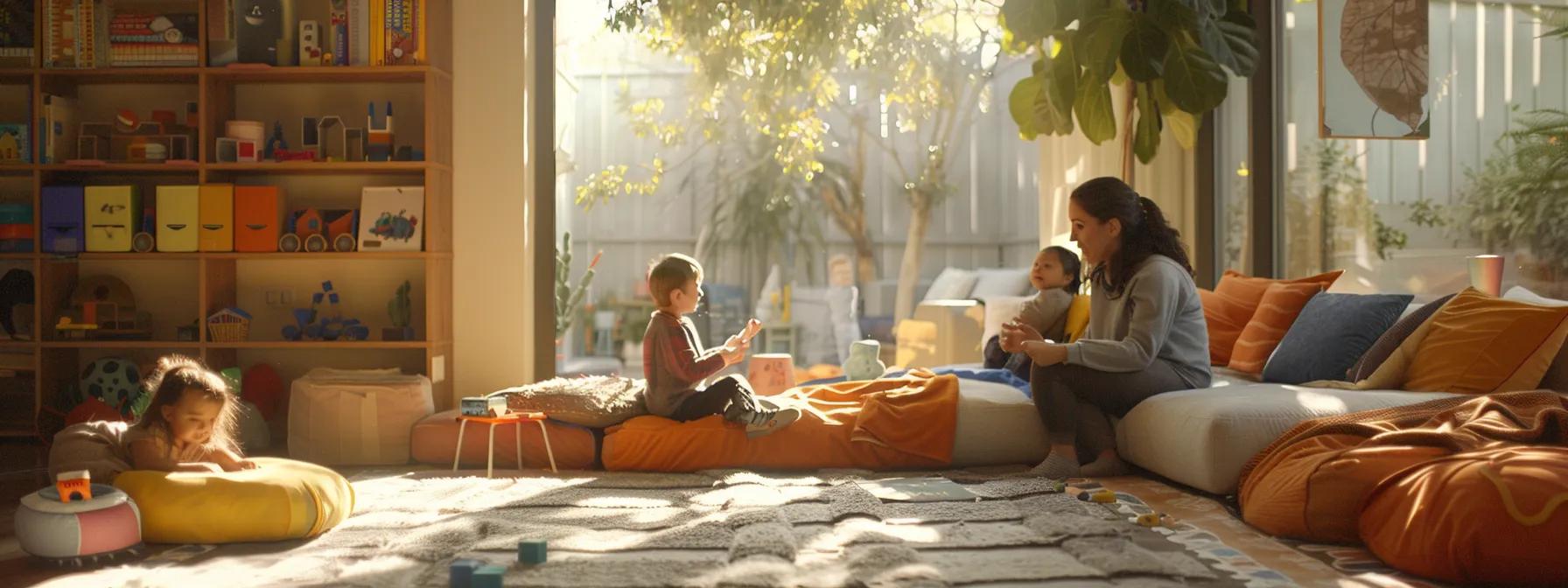


How to Teach Your Children Healthy Boundaries

How to Teach Your Children Healthy Boundaries
In today’s world, establishing healthy boundaries for children is essential for their development and well-being. Setting clear personal and digital boundaries not only protects children from harm but also fosters emotional growth, effective communication, and resilience in challenging situations. This guide offers practical strategies on teaching children about personal space, consent, and how to recognize limits. These principles help mold social skills, self-confidence, and safe interactions—important for families, childcare centers, and schools alike.
Understanding What Child Boundaries Mean for Your Family
Understanding child boundaries starts with defining them as guidelines that help children learn about personal space, emotional privacy, and safe interactions. Personal space means both physical distance and emotional capacity, teaching children that it is acceptable to say “no” when they feel uncomfortable. Boundaries also cover digital safety and screen time management, helping children develop better social skills and emotional resilience. Consistently enforcing boundaries can reduce anxiety and stress while promoting self-esteem. When families model respectful behavior and clear communication—such as discussing body autonomy—children develop healthy interpersonal relationships both at home and in the community.
Defining Personal Space and Physical Child Boundaries
Children learn the value of personal space early on. Physical boundaries inform them when a hug is acceptable and when they can refuse unwanted touch. Using simple, age-appropriate language encourages them to respect differences in proximity and comfort. Studies indicate that children whose personal space is respected tend to have fewer behavioral issues, improved focus, and greater self-control. In addition, understanding physical boundaries promotes safe interactions among peers and helps children protect themselves in potentially harmful situations.
Recognizing Emotional Limits and Feelings as Child Boundaries
Emotional boundaries involve recognizing and respecting one’s own feelings and those of others. When children learn to identify emotions like sorrow, frustration, or happiness, they can better communicate their needs. Teaching them to express distress and seek help when needed supports emotional literacy and reduces tantrums and anxiety. By discussing feelings explicitly and using calm-down techniques, caregivers create a safe environment that builds empathy and aids self-regulation—key skills for managing stress later in life.
Introducing Digital Safety and Online Child Boundaries
With early exposure to online environments, clear digital boundaries are more critical than ever. Teaching children about online privacy, personal data protection, and respectful digital interactions requires practical guidelines. Parents should explain why sharing private information or using others’ devices without permission is unsafe. Structured screen time schedules and regular discussions about digital safety help reduce the risk of online harassment and inappropriate content, while also encouraging critical thinking about technology and privacy.
The Significance of Child Boundaries in Development
Child boundaries are fundamental in shaping social, emotional, and cognitive development. Early boundary-setting builds a framework for independence, self-care, and respectful interaction. Research suggests that children with clear, consistently applied boundaries exhibit better problem-solving skills, focus, and stress management. These guidelines promote self-discipline and ethical behavior in school and within the community, preparing children to handle academic challenges and complex social situations effectively.
Differentiating Healthy Versus Unhealthy Child Boundaries
Healthy boundaries encourage a positive self-image, clear communication, and safe emotional expression. In contrast, unhealthy boundaries—often resulting from inconsistent parenting or chaotic environments—can lead to confusion and conflict. Research shows that healthy boundary-setting is linked to higher self-esteem and academic performance, while unhealthy boundaries may result in miscommunication and behavioral issues. It is crucial for caregivers to identify problematic patterns and address them through open discussion and, if needed, professional support.
Effective Parenting Tips for Establishing Child Boundaries
Effective parenting is key to setting boundaries that foster independence and respect. Parents can begin by modeling respectful behavior, demonstrating clear personal limits, and using simple, age-appropriate language. Consistency in rule-setting helps children learn what to expect, while safe spaces for discussion encourage them to ask questions and express their feelings.
Model Respectful Behavior and Your Own Boundaries
Parents who demonstrate healthy boundaries set a powerful example. When a parent explains why they decline an invitation or maintain personal space, children learn by observing these actions. Nonverbal cues like eye contact and a calm tone reinforce these lessons, teaching children how to interact respectfully. Studies suggest that children who witness consistent boundary-setting become more assertive and confident in social situations.
Use Clear and Age-Appropriate Language for Child Boundaries
Using concrete examples—such as “ask before hugging” or “knock before entering a room”—helps children understand and follow the rules. Simple language minimizes confusion and reinforces the importance of personal safety and respect. This approach builds a foundation for more advanced discussions about consent as children mature.
Start Early With Simple Concepts of Personal Limits
Introducing personal limits early sets the stage for lifelong respect of one’s own and others’ boundaries. Simple activities and stories can illustrate why it is important to say “no” in uncomfortable situations. Early education in boundaries has been linked to reduced anxiety and better conflict-resolution skills, preparing children for future social interactions.
Be Consistent With Rules About Child Boundaries
Consistency is critical for building trust and predictability. When all caregivers enforce the same rules—whether it’s asking permission for hugs or maintaining quiet times—children understand that these limits are essential rather than arbitrary. Regular review of these rules helps to integrate them into daily routines, creating a secure environment.
Create a Safe Space for Discussing Child Boundaries
A safe, open dialogue about boundaries lets children express feelings and talk about challenges they face. Family meetings or one-on-one conversations provide opportunities for children to discuss times when their limits were tested. Validating these feelings and discussing ways to address issues help to prevent conflicts from escalating and build stronger self-esteem.
Instilling the Principles of Teaching Consent Early On
Teaching consent from a young age is integral to establishing healthy boundaries. Children learn that their bodies and feelings belong to them, and they have the right to decide who can touch them. Early lessons on consent empower children to say “no” when necessary and help prevent abuse, nurturing respectful interactions at home and in school.
Explaining Bodily Autonomy as a Foundation for Teaching Consent
Bodily autonomy means that each child has control over their own body. By using simple phrases like “Your body belongs to you,” caregivers lay the groundwork for understanding consent. This explanation, paired with everyday examples, helps children appreciate the importance of respecting personal space and sets the stage for later discussions about more complex consent issues.
Teaching Children to Ask for and Recognize Permission
It is essential for children to understand the importance of asking for permission before entering someone else’s space or using their belongings. Role-playing and routine phrases such as “May I?” encourage courteous behavior and build mutual respect. Children learn that consent is an ongoing process of communication rather than a one-time response.
Helping Kids Understand They Can Say No
Children must also learn that saying “no” is a fundamental right. Regularly reinforcing that their feelings are valid enables them to decline unwanted interactions confidently. Consistent practice through role-playing scenarios and affirmations helps children manage peer pressure and external influences, supporting safer and more respectful environments.
Role-Playing Scenarios for Teaching Consent
Interactive role-playing exercises allow children to practice asking for permission, refusing unwanted advances, and navigating disagreements. These activities enhance communication skills and empathy. Through simulated situations, children become more comfortable with expressing their boundaries and understanding others’ limits, making respectful behavior second nature.
Respecting a Child's "No" to Reinforce Teaching Consent
It is vital for caregivers to respect a child’s refusal immediately and without question. By validating a child’s “no,” caregivers reinforce that their boundaries must be honored. This practice builds self-esteem and teaches children that their decisions are important, establishing a foundation of mutual respect for all future interactions.
Communicating Effectively About Child Boundaries and Consent
Clear communication is essential in teaching and reinforcing boundaries and consent. Effective dialogue helps ensure that children feel safe and understood, while also equipping them with skills to handle conflicts.
Active Listening to Your Child's Feelings About Boundaries
Active listening involves paying full attention to a child’s verbal and nonverbal cues. When children express discomfort or uncertainty, caregivers should listen with empathy and validate those feelings. This approach builds trust and encourages children to share their experiences openly.
Using "I" Statements to Express Your Own Boundaries
By using “I” statements—such as “I feel worried when you play too roughly”—caregivers can model clear, non-confrontational communication. This technique helps children learn how to express their own boundaries respectfully and effectively, reducing conflicts.
Practical Parenting Tips for Discussing Boundary Violations
Addressing boundary violations immediately and calmly is crucial. Caregivers should explain why a behavior is unacceptable and discuss ways to make better choices. Using real-life examples and maintaining an ongoing conversation about these issues helps children understand the importance of boundaries and offers them strategies to resolve conflicts constructively.
Reinforcing Verbal Cues With Non-Verbal Signals
Non-verbal communication, including facial expressions, tone of voice, and gestures, plays a key role in reinforcing messages about boundaries. A supportive posture or gentle nod when a child expresses their concerns strengthens the verbal message and builds confidence in their ability to assert themselves.
Encouraging Open Dialogue About Child Boundaries and Consent
Regular, open conversations about boundaries and consent should be part of everyday life. Asking simple questions and sharing personal experiences in an age-appropriate manner normalizes these topics. Such dialogue helps children internalize these values, reducing misunderstandings and promoting respectful interactions across various settings.
Addressing Common Challenges in Teaching Child Boundaries
Challenges in teaching boundaries can arise from repeated testing, peer pressure, or external influences like media. A multi-faceted approach—combining consistent rule enforcement, open communication, and periodic review—helps caregivers navigate these issues effectively.
What to Do When a Child Tests Boundaries
When children test limits, caregivers should respond with calm, consistent guidance. Explaining why certain actions are unacceptable and discussing alternative choices reinforces the rules without instilling fear or frustration. Positive reinforcement when children respect boundaries further solidifies their understanding.
Guidance for When Others Overstep Your Child's Boundaries
If peers or other adults overstep a child’s boundaries, caregivers need to intervene immediately. Clear, calm communication reinforces the child’s expressed limits and educates others about respectful behavior, ensuring that the child’s sense of safety remains intact.
Navigating Peer Pressure and Child Boundaries
Peer pressure can tempt children to compromise their limits. Parents can help by role-playing scenarios and discussing practical strategies for saying “no.” Consistent support and clear rules build confidence and empower children to resist negative influences.
Adjusting Child Boundaries as They Grow
As children mature, their needs and social experiences change. Regularly revisiting boundary rules and adjusting them to suit different developmental stages ensures that these guidelines remain relevant. Involving children in these discussions helps them internalize and respect the evolving limits.
Parenting Tips for Handling Resistance to New Boundaries
Resistance to new rules can be managed with patience and clear explanations. Gradually introducing changes, offering choices within set limits, and reinforcing the reasons behind the adjustments make transitions smoother. Empathetic conversations about why new boundaries are necessary build trust and cooperation.
Nurturing Respect for Boundaries and Teaching Consent Long-Term
Long-term respect for boundaries is nurtured through daily practice and continuous reinforcement. Establishing these values early on ensures they persist into adulthood, forming the basis for healthy relationships.
Building Empathy to Understand Others' Limits
Empathy is central to respecting boundaries. Encouraging children to consider others’ feelings—through cooperative games, group projects, and discussions of different perspectives—cultivates an empathetic mindset. This awareness helps children appreciate the importance of not overstepping limits in all relationships.
Empowering Children to Set Their Own Child Boundaries
When children are involved in creating their own set of boundaries, they develop a stronger sense of autonomy. Constructive conversations and decision-making exercises foster self-advocacy, equipping children with the skills needed to manage difficult situations and reinforcing their confidence.
Praising Respectful Behavior and Boundary Setting
Positive reinforcement through praise and specific feedback encourages children to continue respecting personal limits. Recognizing efforts to adhere to boundaries builds self-esteem and establishes these practices as habitual, resulting in lasting behavioral improvements in both home and community settings.
Connecting Child Boundaries to Healthy Relationships
Linking the concept of boundaries to the formation of healthy relationships helps children understand their broader significance. Classroom discussions and collaborative activities that emphasize respect and trust illustrate that boundaries are empowering tools—essential for developing positive relationships throughout life.
Communicating Effectively About Child Boundaries and Consent
Clear, continuous communication reinforces the importance of boundaries. A combination of active listening, use of “I” statements, and supportive non-verbal cues creates a trusting environment where children feel safe to express their needs and concerns. Regular conversation about these topics ensures the principles of consent become integrated into everyday behavior, promoting respectful interactions in every context.
Addressing Common Challenges in Teaching Child Boundaries
Challenges such as repeated boundary testing, peer pressure, and external distractions require flexible strategies. By combining consistent rule enforcement, empathetic dialogue, and guided problem-solving, caregivers can help children navigate these challenges. Every setback provides an opportunity to discuss why boundaries matter and to reinforce the values of self-respect and respect for others.
Nurturing Respect for Boundaries and Teaching Consent Long-Term
Sustained reinforcement of healthy boundaries and consent throughout childhood lays the groundwork for emotional intelligence and positive social behavior in adulthood. Regular check-ins, role modeling, and positive reinforcement create a secure base from which children learn to navigate increasingly complex interpersonal relationships. This long-term commitment ultimately develops a community built on respect, trust, and clear communication.
Frequently Asked Questions
Q: How can early boundary education affect a child's social development? A: Early boundary education instills self-respect and empathy, enabling children to communicate their needs clearly. Children with well-defined limits tend to be more confident, display better social skills, and experience fewer conflicts with peers.
Q: What are the most effective strategies for teaching consent to young children? A: Effective methods include role-playing, using age-appropriate language, and consistently reinforcing that personal space is sacred. These techniques, combined with active listening and “I” statements, help children understand and internalize the concept of consent.
Q: How can caregivers manage situations when a child tests their boundaries repeatedly? A: Consistent, calm guidance is essential. Addressing each instance individually with clear explanations and positive reinforcement helps children learn acceptable behavior and reinforces the importance of boundaries.
Q: What role does digital safety play in establishing healthy boundaries? A: Digital safety is critical; clear guidelines for screen time and online privacy protect children from harmful content and teach them about respect and consent in the digital world.
Q: How can parents ensure consistent communication about boundaries at home and school? A: Regular discussions, collaborative rule-setting, and unified strategies among caregivers and educators ensure that children receive a balanced message about personal space and consent across all environments.
Q: What should a caregiver do if other adults overstep a child’s boundaries? A: Immediate, calm intervention is necessary. Reinforcing the child’s limits and explaining the importance of personal space to the other adult helps maintain a respectful environment.
Q: Why is it important for children to learn to say "no"? A: Learning to say “no” empowers children, fostering self-advocacy and protecting their emotional and physical well-being. This skill builds confidence and establishes a culture of mutual respect, crucial for healthy relationships.
Final Thoughts
Teaching children healthy boundaries and consent is a multifaceted process that relies on consistent communication, modeling, and reinforcement. By establishing clear physical, emotional, and digital boundaries from an early age, caregivers can foster self-esteem, resilience, and respectful interactions. The strategies presented here create a nurturing environment where children safely explore their autonomy and develop effective communication skills. In the long run, these practices build the foundation for positive relationships and sustained emotional well-being.

Infant Care
Nurturing and caring environment for your little one's growth.

Toddler Care
Nurturing growth and discovery in a safe, loving environment.

Preschool
Nurturing creativity and growth in a safe, engaging environment.
Ga Pre-K Lottery
Unlock educational opportunities with our Ga Pre-K Lottery program.
AfterSchool
Enriching and safe after-school care tailored to children's growth.
Kindergarden
Nurture young minds with personalized attention and engaging activities.
Testimonials
Our Parents love us
Here's some of what they had to say
My daughter has been going here for a year. She and we love it! The staff is very kind and helpful. They listen to my concerns and always help her and engage her with activities that fit her abilities instead of just her age! We have restricted diet; they work with us to accommodate her. Chroma has become our second family!
Khawla M.

My daughter loves it here. She loves all her teachers, she learns something new every day. We love the activities they provide our child with.
Jessica B.
